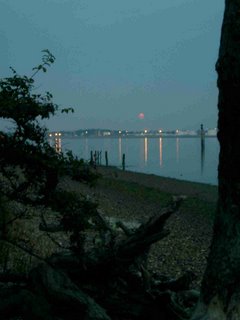Life is full of contrasts, and at Christmas we seem to have lost our sense of spirituality, and now worship at the altars of consumerism.
Yesterday evening I represented the Holly King in the Yuletide ritual, we had a jolly time, ate good food, enjoyed a glass of mulled wine made from bullaces (small plums) and exchanged hand-made presents, poems were read, songs were sung, a happy band of people joined together to enjoy each other's company.
And afterwards, realising too late that I'd not really prepared for Xmas I went to the Tesco supermarket in Martlesham, near Ipswich, Suffolk (and you all know where that is by now). It was 11pm - the place was packed!
As young east-european men stacked the shelves, working with industry, the fat English waddled through the aisles, loading trolleys with garishly coloured cardboard boxes, believing them to contain food.
It could be described as a scene from Hell. Not Dante's Inferno, except most of the English could be described as Opportunists, for many had done little to deserve their riches. Perhaps they should have been in the fourth circle of the Inferno for their greed had overtaken all other passions. I was left wondering how to label the world we have created.
Tesco at midnight is about as bad as I want it to get.
Just tested my carbon footprint - look at
www.thersa.org/carbon and found I've use about 2.3 tonnes - below the 4 tonne limit suggested. Try it yourself.
We must start respecting our planet. In the last 60 years the population has grown from 2 billion to over 6 billion, and will soon rise to 9 billion. That cannot continue. In the past famine, pestilence and war have kept the population at reasonable levels. Now we are in real danger.
The two snakes, one red, one white, continue to grow, using more of our precious mineral wealth, polluting the air we breath as they weave their way around all the lands. Stop using your car. Get a bike. Walk whenever you can. Use local shops. Try to avoid supermarkets.
Consumerism puts a price on everything, but it's a failing economic system. Americans pollute more than any other group. Their economy relies upon growth and to keep growing they just keep building up the debt they owe the rest of the world. It is crass stupidity.
A few more degrees warmer and the permafrost of Russia will begin to melt. There are peat bogs that are bigger than France and Germany combined which contain methane, at present locked up in the ice. Methane is worse that carbon dioxide at increasing the global temperature. There's a time bomb waiting we will not be able to control.
Gaia will survive. It is
homo sapiens who will be destroyed.
Think about that before you jump on a plane: a third of the population of Ireland flew to New York to do their Xmas shopping this year. Isn't that mad?
Cars, planes, heating badly insulated houses, carrying goods from one side of the globe to the other, all burn fossil fuels - precious, irreplaceable materials that have taken millions of years to be produced.
The results will be catastrophic.
Think of your grandchildren's children. They may never exist because of your negligence.
The light is coming, we have moved from the darkness, there's a bright future ahead. Let's work hard to make it happen.







